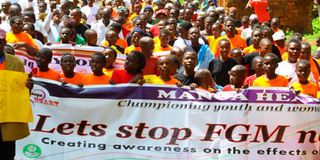We must prioritise collection of data to end violence against women, girls

Nyamira County residents and children take part in a walk to mark the 16 days of activism against Gender-Based Violence on December 5, 2017. Nyamira has been registering high FGM cases.
What you need to know:
- In Kenya, with the help of several women’s rights organisations, in partnership with the government, FGM has considerably dropped.
- This is largely attributed to heightened sensitisation in areas where it is rampant.
The thorny issues of teenage pregnancy, child marriages, and female genital mutilation/cut have refused to go away even as the government and the civil society fight to eliminate them.
Eradicating FGM has never been this urgent for Kenya, where it is estimated that nearly 9.3 million girls and women have undergone the cut, a violation of their rights.
Ending the retrogressive practice is urgent given that it is criminalised in all its forms by the Prohibition of Female Genital Mutilation Act, (2011).
President Uhuru Kenyatta committed to end FGM in November 2019 at the Nairobi Summit on the International Conference on Population and Development (ICPD25). It was part of the meeting’s five themes.
The meeting noted that the future of sustainable development is directly linked to fulfilling the aspirations of adolescents and youth. Empowering the world’s 1.8 billion young people and unleashing their full potential to contribute to economic and social progress is thus instrumental for bringing the vision and the promise the ICPD Programme of Action and of the 2030 Agenda for Sustainable Development to life.
Despite remarkable progress over the past 25 years, the promise of the ICPD Programme of Action remains a distant reality for millions of people across the world.
Demolish barriers
But there’s hope in Kenya. With the help of several women’s rights organisations, in partnership with the government, FGM has considerably dropped. This is largely attributed to heightened sensitisation in areas where it is rampant.
The crackdown by the government of those ignoring the law and having them prosecuted has also, to some extent, discouraged the practice. Despite all this, there are still miscreants who have refused to let go of the regressive practice. They maintain it’s cultural. They will go to all levels to dodge the law and accomplish their mission, and with it, ruining lives of girls, including keeping them out of school.
We must employ innovation and technology to fight FGM and child marriages, teenage pregnancies, demolish barriers to gender equality and equity, and end Sexual and Gender-Based Violence (SGBV). One of the effective ways is through use of data.
This is particularly important for the media, which plays a fundamental role in informing, educating and in the dissemination of information, particularly on social issues.
The critical role of media in raising awareness on such repugnant social issues in addition to others that affect women and girls cannot be gainsaid. This role also includes shaping public discourse and influencing public policy.
This then, is where use of data, in this case for positive impact on issues of gender and specifically, those that have a negative effect on the lives of girls and women.
Influence government policy
Civil society organisations, particularly those that work at the grassroots in counties where the violations against girls are rampant, often collect data on the same.
In some cases, however, such data ‘gets lost’ in their files, as they probably consider what to do with them. There are organisations and institutions that have used the data they collect during their sensitisation campaigns to create a positive impact on the ground.
With statistics on what afflicts girls in their communities and the extent of the consequences on the society, local leaders, including elders, parents, teachers and other opinion shapers should intensify empowerment campaigns.
Accessibility to, collection of correct and credible data on issues that affect women and girls, and highlighting the same by media and organisations that work around rights of the female gender is central in influencing policy decisions.
Recently, the Journalists for Human Rights Kenya, through its programme, ‘Voice for Women and Girls Rights Kenya’, facilitated an important conversation between the civil society and the media, focusing on the crucial need to highlight appropriate data to effectively report on human rights violations of girls and women, such as FGM, teenage pregnancies, and SGBV.
It is crucial for the media and civil society to work together in collection of data that has effect on women and girls.





